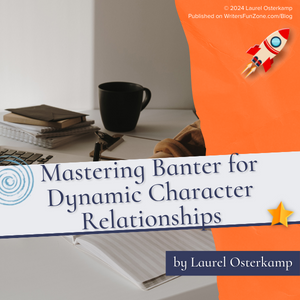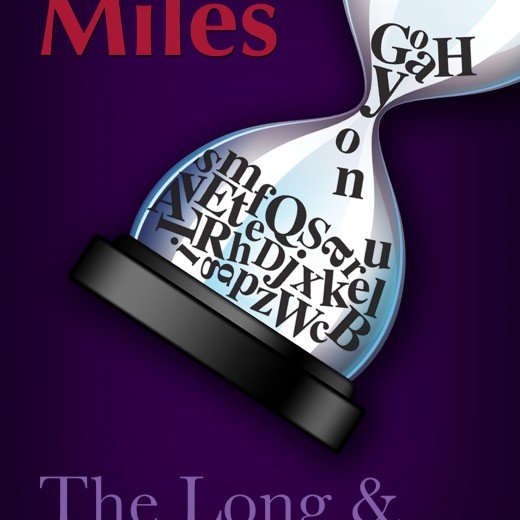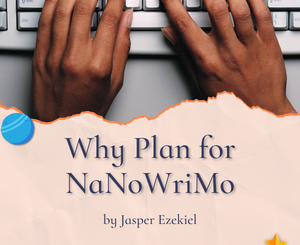Mastering Banter for Dynamic Character Relationships by Laurel Osterkamp
 Let’s welcome back Laurel Osterkamp as she shares with us “Mastering Banter for Dynamic Character Relationships.” Enjoy!
Let’s welcome back Laurel Osterkamp as she shares with us “Mastering Banter for Dynamic Character Relationships.” Enjoy!
***
You’re reading a really excellent novel, and two of the main characters — whether they’re friends, rivals, or lovers (or perhaps all three)–have this amazing dynamic. It’s like they connect on a whole different level; it’s almost as if they speak their own private language.
That, my friend, is an example of effective banter, which is essential for creating a compelling and dynamic relationship between your main characters. Banter can add depth, humor, and realism to character interactions.
Done well, banter reveals the dynamics of a relationship, showcases the personalities of the characters, and even foreshadows future events. But most of all, effective banter distinguishes the relationship or connection between your two main characters as special and/or one of a kind.
But it can be hard, making your characters brilliant, clever, and glib. Whenever I want to add some mind-blowing banter, I immediately become blocked. (Try saying that three times fast.)
Fear not: there are tools you can use to make writing banter a little bit easier.
1. Know Your Characters
Before you can create compelling banter between your characters, you need to have a deep understanding of their personalities, backgrounds, and motivations. Take the time to flesh out your characters’ traits and quirks, their history with one another, and the dynamics of their relationship.
In Good Girl’s Guide to Murder by Holly Jackson, the banter between Pip and Ravi reveals the fundamental personality traits and conflicts of both characters. Like this scene, which comes early in the novel:
Pip tried her best not to look hurt. “I’m not messing, I promise. I’m serious.”
“Yeah, you seem like the serious type.” The back of his head must have been exceptionally itchy. Or maybe Ravi Singh’s itchy head was the equivalent of Pip’s overexplaining.
“I’m irrationally serious,” Pip smiled, holding the Tupperware out to him. “And I made muffins.”
“Like bribery muffins?”
“That’s what the recipe said, yeah.”
Ravi’s mouth twitched; not quite a smile. Pip only then appreciated how hard his life must be in this town…
2. Use Dialogue Tags and Actions
Dialogue tags and actions are powerful tools that can help elevate your banter. Instead of relying solely on dialogue, use descriptive tags and actions to add depth and context to your characters’ conversation.
This will not only make the banter more engaging but also paint a vivid picture of the characters’ emotions and intentions.
For example, in Lesley Nneka Arimah’s short story “Glory,” banter is sandwiched between dialogue tags and actions that adds to its impact.
“Sorry, I don’t really know anyone either. You should try talking to someone with real friends.”
He laughed, thinking she was joking, and his misunderstanding loosened her tongue. It was nice to talk to someone with no expectations of her.
“So, why are you slumming it here with the rest of us? Shouldn’t you be interning somewhere fabulous?”
3. Add Conflict
Conflict is always compelling and can add tension to the scene. This can also be an effective tool for character development, as it can reveal their flaws, fears, and desires.
In Happy Place by Emily Henry, Harriet and Wyn’s first meeting is full of verbal missteps and misunderstandings, which provides just the right amount of conflict. We instantly know that these two characters will challenge each other, but in a good way.
“Your hair’s almost black. In the moonlight, it looks blue.”
“Blue?” I say. “You think my hair is blue?”
“Not like, Smurf blue,” he says. “Blue black. You can’t tell in pictures. You look different.”
“It’s true,” I say. “In real life, I’m three-dimensional.”
4. Use Pop Culture References
Pop culture references can add a layer of realism to your characters and make them more relatable.
They can also add humor and serve as a way for characters to bond and connect with each other.
However, it is important to use references that are relevant to your characters and their interests, and not just for the sake of it.
In Check & Mate by Ali Hazlewood, Mallory and Nolan are both chess superstars, so their banter is often filled with pop culture references relevant to their world.
“Fine.” I sit across from him, as distant as possible. This is what I get for refusing pizza. “But I’m not going to play, so–”
“Chess.”
“What?”
“You said you wouldn’t play chess. You didn’t mention anything else, so…” He turns the flier to me. He has drawn a three-by-three grid, put an X through a space, and…
I laugh. “Tic-tac-toe? Really?”
“Unless you have Uno handy? Checkers? Operation?”
“This is worse than Candy Crush.”
5. Make it Relevant to the Plot
Banter should not only serve as a way to showcase the characters’ personalities and relationships but also advance the plot.
It should reveal something about the characters, their motivations, and the story.
Use banter to foreshadow future events or add clues and hints that will be important later in the story.
In Daphne Du Maurier’s classic My Cousin Rachel, Phillip and Rachel are constantly testing each other while bantering.
Occasionally, they reveal unexpected truths which hints at events to come.
There was a long silence. Then, she said, “Only these two?”
“Only those two,” I answered.
“Nothing after Easter, or Whitsun, did you say, until these came?”
“No, nothing…”
“How you must have hated me,” she said slowly.
I looked up, startled… “Yes,” I said.
Crafting compelling and clever banter is a skill that takes time and practice to master.
By knowing your characters, using dialogue tags and actions, incorporating humor and conflict, and making it relevant to the plot, you can create banter that captures the essence of your characters and adds depth and richness to your story.
As you write, remember to let your characters’ personalities shine through, and don’t be afraid to let them surprise you with their banter.
After all, they are the ones who will ultimately bring your story to life.
***
About the Author
 Laurel Osterkamp is from Minneapolis, where she teaches and writes like it’s going out of style. Her short fiction has been featured in Abandon Journal, Idle Ink, Tangled Locks Literary Journal, Bright Flash Literary Journal, and The Metawoker, among other places. Her novel Favorite Daughters was released last year by Black Rose Writing, and her new novel, Beautiful Little Furies, will be released in December.
Laurel Osterkamp is from Minneapolis, where she teaches and writes like it’s going out of style. Her short fiction has been featured in Abandon Journal, Idle Ink, Tangled Locks Literary Journal, Bright Flash Literary Journal, and The Metawoker, among other places. Her novel Favorite Daughters was released last year by Black Rose Writing, and her new novel, Beautiful Little Furies, will be released in December.
Social Media:
Website – https://laurellit.com
Facebook – https://www.facebook.com/authorlaurelosterkamp
BookBub – https://www.bookbub.com/profile/laurel-osterkamp
Instagram: Laurel Osterkamp (@laurel_osterkamp) • Instagram photos and videos






